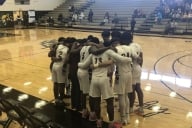You have /5 articles left.
Sign up for a free account or log in.

Binghamton University
Binghamton University hopes to spearhead a new era of high-profile collegiate baseball in the Northeastern U.S. with a new $60 million stadium complex fully funded by an anonymous donor family.
The university, which is part of the State University of New York system, is well-known in the Northeast for its academic rigor but does not have much of a national profile, said Barry Jones, an economics professor and chair of the Faculty Senate’s Executive Committee. The baseball stadium, which will have the capacity to host National Collegiate Athletic Association postseason championships, will likely raise the university's profile, said Pat Elliot, Binghamton’s athletic director.
“It's a world-class academic institution. We strive in every area of this university to be the best that we can be,” Elliot said. “For us to be able to get into the postseason, and win championships, and into the national tournament, that raises the profile of all of our teams, of all of our programs” and also gets “the Binghamton University name out there nationally.”
The donation announced Feb. 11 is the largest in Binghamton’s 74-year history and comes in the midst of the quiet phase of a seven-year fundraising campaign, university president Harvey Stenger said.
He noted that alumni are now beginning to make substantial donations to the university. In the last two years, the university has received more than 14 million-dollar gifts, compared to five such gifts between its founding in 1946 and 2018, Stenger said.
The $60 million donation marks the second-largest gift to a SUNY campus, said Kristina Johnson, chancellor of the SUNY system. She said the system did not raise money from private sources when it was first founded. But when she became chancellor in 2017, she made it one of her goals to encourage more philanthropy in order to fund the building of new facilities and compete with the donor support flagship universities across the country receive.
“Philanthropy is another revenue stream and allows us to do things that we wouldn’t really be contemplating without that support,” Johnson said. “It is the opportunity to show that there’s excellence across the State University of New York, that donors and alumni are getting excited about giving and seeing what SUNY can do with those incremental dollars.”
Some commenters on Binghamton’s Facebook announcement about the stadium questioned the planned use of the gift and noted that a donor put $2.2 million toward an upgrade to the university’s current baseball field in 2016, the Binghamton Press & Sun-Bulletin reported. Though reactions on social media were generally positive, some people mentioned more investment in mental health resources for students, tuition discounts and scholarships as alternatives or better uses for the $60 million.
Amir Pasic, dean of the Lilly Family School of Philanthropy at Indiana University-Purdue University Indianapolis, said it's uncommon for a gift of $50 million or more to go toward athletics and that such large donations tend to be spent on facilities, major research or financial aid. He said in some instances university officials may be able to convince a donor who wants a gift used for a specific purpose to allow the institution to redirect the money to a different priority of the university.
Still, Pasic said, donations that go toward athletics can also serve an institution's larger and more long-term priorities well.
“Athletics also has an impact on the visibility of the university’s capacity to attract students,” he said. “It’s clearly something that makes a big difference to the branding of the place and its ability to attract students, alumni, members of the community to the games … Whenever you get an infusion of funds like this, it’s usually of dramatic consequence.”
Athletics also “raise serious money” and “have big followings,” said James Finkelstein, professor emeritus at the Schar School of Policy and Government at George Mason University and an expert on university presidents. But donors making demands as to how their money is spent is becoming a widespread issue for leaders across higher education, said Judith Wilde, a professor at and COO of the Schar School. Wilde referenced a 2019 Inside Higher Ed survey of college presidents, where one-third said they rejected gifts because of requirements on how the funds could be used.
“Whenever a donor starts setting requirements for a gift, besides naming requirements, there might be a problem there,” Wilde said.
When universities maintain good relationships with donors, they will generally give to “a multitude of programs” over time, said Johnson, the SUNY system's chancellor. She said she does not know the identity of the $60 million donor family but is hopeful their philanthropy will inspire others to give to SUNY.
“This was definitely the family’s desire. Baseball was why they were coming to us with this gift,” Stenger said. “In development 101, that’s the message that you have to follow through on. It’s best to go on their direction, assuming that it’s beneficial to your university … rather than trying to steer a gift in a direction that may not be what their interests are.”
Binghamton’s baseball team is the most successful of the university's various Division I athletics programs. It has won 10 America East conference regular and postseason titles in the last 13 years, according to the university's online announcement of the donation. The Bearcats have advanced to the NCAA regional competition three times since 2013, and nine Binghamton baseball alumni have gone on to the major leagues in the last eight years.
The baseball team deserves a good field to play on, said Matthew McConn, chair of the teaching, learning and educational leadership department. McConn is a member of the university's Intercollegiate Athletics Board, a group of faculty members, students and staff that advises Stenger about twice a year and provides feedback on the academic performance of team athletes. The board was not involved in discussions about the donation or the plans for a new baseball stadium, but senior members of the university's faculty governing bodies were, Stenger said.
McConn, who is the new chair of his department, said increasing enrollment is a top priority and investment in athletics can bring some positive attention to Binghamton.
“A new baseball stadium, I think he’d be crazy to pass that up, because that’s the type of thing that brings new students,” McConn said of Stenger. “Any time that you can get more national recognition, it helps all around. We’re always looking for more nationally recognized scholars, and anytime you can get the BU name out there, that helps.”
The 84,000-square-foot stadium complex will be built on an aggressively fast timeline -- the first phase, with seating, press boxes, entertainment space and the baseball team’s clubhouse, is scheduled to be complete in spring 2021, said Ryan Yarosh, Binghamton's senior director of media and public relations. Construction for the second phase, the team’s new indoor practice facility, does not yet have dates, he said.
Johnson said the construction portion of the stadium itself will create 670 jobs over the next year or so in the area of Binghamton and Vestal, N.Y., where the team’s current facilities are located. Jones, the economics professor, said the area is “a baseball town” and predicted the stadium will benefit the local economy.
“Hopefully people from the surrounding community will come in and watch baseball games,” Jones said. “Athletics also has the potential to excite the alumni when they leave campus.”








